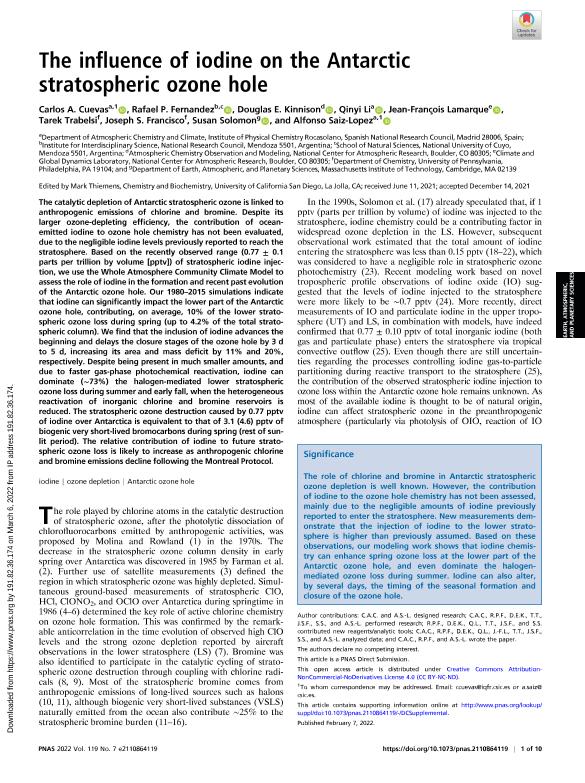Artículo
The influence of iodine on the Antarctic stratospheric ozone hole
Cuevas, Carlos Alberto; Fernandez, Rafael Pedro ; Kinnison, Douglas E.; Li, Qinyi; Lamarque, Jean François; Trabelsi, Tarek; Francisco, Joseph S.; Solomon, Susan; Saiz López, Alfonso
; Kinnison, Douglas E.; Li, Qinyi; Lamarque, Jean François; Trabelsi, Tarek; Francisco, Joseph S.; Solomon, Susan; Saiz López, Alfonso
 ; Kinnison, Douglas E.; Li, Qinyi; Lamarque, Jean François; Trabelsi, Tarek; Francisco, Joseph S.; Solomon, Susan; Saiz López, Alfonso
; Kinnison, Douglas E.; Li, Qinyi; Lamarque, Jean François; Trabelsi, Tarek; Francisco, Joseph S.; Solomon, Susan; Saiz López, Alfonso
Fecha de publicación:
02/2022
Editorial:
National Academy of Sciences
Revista:
Proceedings of the National Academy of Sciences of The United States of America
ISSN:
0027-8424
Idioma:
Inglés
Tipo de recurso:
Artículo publicado
Clasificación temática:
Resumen
The catalytic depletion of Antarctic stratospheric ozone is linked to anthropogenic emissions of chlorine and bromine. Despite its larger ozone-depleting efficiency, the contribution of oceanemitted iodine to ozone hole chemistry has not been evaluated, due to the negligible iodine levels previously reported to reach the stratosphere. Based on the recently observed range (0.77 ± 0.1 parts per trillion by volume [pptv]) of stratospheric iodine injection, we use the Whole Atmosphere Community Climate Model to assess the role of iodine in the formation and recent past evolution of the Antarctic ozone hole. Our 1980-2015 simulations indicate that iodine can significantly impact the lower part of the Antarctic ozone hole, contributing, on average, 10% of the lower stratospheric ozone loss during spring (up to 4.2% of the total stratospheric column). We find that the inclusion of iodine advances the beginning and delays the closure stages of the ozone hole by 3 d to 5 d, increasing its area and mass deficit by 11% and 20%, respectively. Despite being present in much smaller amounts, and due to faster gas-phase photochemical reactivation, iodine can dominate (∼73%) the halogen-mediated lower stratospheric ozone loss during summer and early fall, when the heterogeneous reactivation of inorganic chlorine and bromine reservoirs is reduced. The stratospheric ozone destruction caused by 0.77 pptv of iodine over Antarctica is equivalent to that of 3.1 (4.6) pptv of biogenic very short-lived bromocarbons during spring (rest of sunlit period). The relative contribution of iodine to future stratospheric ozone loss is likely to increase as anthropogenic chlorine and bromine emissions decline following the Montreal Protocol.
Palabras clave:
ANTARCTIC OZONE HOLE
,
IODINE
,
OZONE DEPLETION
Archivos asociados
Licencia
Identificadores
Colecciones
Articulos(ICB)
Articulos de INSTITUTO INTERDISCIPLINARIO DE CIENCIAS BASICAS
Articulos de INSTITUTO INTERDISCIPLINARIO DE CIENCIAS BASICAS
Citación
Cuevas, Carlos Alberto; Fernandez, Rafael Pedro; Kinnison, Douglas E.; Li, Qinyi; Lamarque, Jean François; et al.; The influence of iodine on the Antarctic stratospheric ozone hole; National Academy of Sciences; Proceedings of the National Academy of Sciences of The United States of America; 119; 7; 2-2022; 1-10
Compartir
Altmétricas



